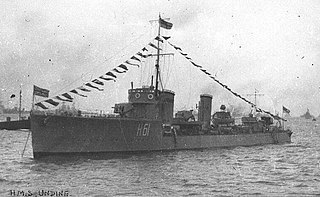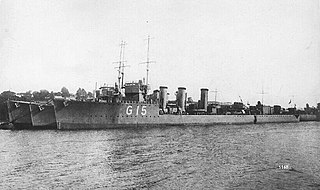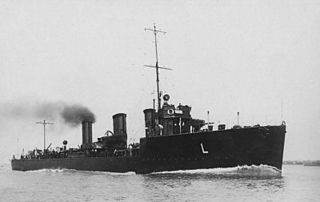
HMS Tristram was a modified Admiralty R-class destroyer that served in the Royal Navy during the First World War. The Modified R class added attributes of the Yarrow Later M class to improve the capability of the ships to operate in bad weather. Launched in 1917, the destroyer was operational for just over four years. In 1917, Tristram joined the Grand Fleet and provided distant cover at the Second Battle of Heligoland Bight but did not engage with the enemy. After the armistice which ended the war, the destroyer was initially transferred to the Home Fleet before being placed in reserve in 1920 and then sold to be broken up in 1921.

HMS Ulster was a modified Admiralty R-class destroyer that served in the Royal Navy during the First World War. The Modified R class added attributes of the Yarrow Later M class to improve the capability of the ships to operate in bad weather. Launched on 10 October 1917, the vessel served with the Grand Fleet. After the war, the destroyer was placed initially in the Home Fleet, but then moved to the Reserve Fleet before, on 21 April 1928, being sold to be broken up.

HMS Undine was a Modified Admiralty R-class destroyer that served in the Royal Navy during the First World War. The Modified R class added attributes of the Yarrow Later M class to improve the capability of the ships to operate in bad weather. Launched in 1917, the destroyer served in the Grand Fleet until the end of the war. Undine was sold to be broken up in 1927 but was wrecked on the way to the breakers. The wreck was partially visible in 2013.

HMS Urchin was a Modified Admiralty R-class destroyer which served with the Royal Navy during the First World War. The Modified R class added attributes of the Yarrow Later M class to improve the capability of the ships to operate in bad weather. The destroyer was the third ship in the Navy to be named after the sea urchin and the first in the class to be built by Palmers in Jarrow. Launched in 1917, Urchin served with the Grand Fleet, seeing action in the Second Battle of Heligoland Bight. After the war, the destroyer was remained in service until being retired and sold to be broken up in 1930.

HMS Ursula was a Modified Admiralty R-class destroyer that served in the Royal Navy. The Modified R class added attributes of the Yarrow Later M class to improve the capability of the ships to operate in bad weather. The vessel was launched in 1917 at Greenock in Scotland and served with the Grand Fleet during the First World War. After the war, the destroyer was transferred to the Home Fleet, but then moved to the Reserve Fleet. In 1924, Prince George served aboard Ursula before, in 1929, the vessel was sold to be broken up.

HMS Tirade was a Modified Admiralty R-class destroyer which served with the Royal Navy during World War I. The Modified R class added attributes of the Yarrow Later M class to improve the capability of the ships to operate in bad weather. Launched in April 1917 by Scotts Shipbuilding and Engineering Company, the vessel served with the Grand Fleet. The vessel was involved in escorting convoys in the Irish Sea and North Sea. During one of these duties, in September 1917, Tirade sank the minelaying submarine UC-55. During the following month, the destroyer accidentally struck and sank the M-class destroyer Marmion. After the war the destroyer was placed in reserve and then, in November 1921, was sold to be broken up.

HMS Umpire was a modified Admiralty R-class destroyer which served with the Royal Navy. The Modified R class added attributes of the Yarrow Later M class to improve the capability of the ships to operate in bad weather. Launched on 9 June 1917, the ship operated with the Grand Fleet during World War I as an escort to a squadron of light cruiser and took part in the Second Battle of Heligoland Bight. After the Armistice, the vessel continued to serve and gained fame when, after rescuing the charity's founder from drowning in 1924, the name of the first house opened by what would become Veterans Aid was named H10 after the destroyer's pennant number. Umpire was sold to be broken up in 1930.

HMS Rigorous was an R-class destroyer which served with the Royal Navy during World War I. Launched on 30 September 1916, the vessel operated as part of the Grand Fleet, operating as part of destroyer flotillas hunting German ships that were attacking convoys. One flotilla was successful in destroying a Q ship in 1917. After the War, the destroyer was given a reduced complement and was sold to be broken up on 5 November 1926.

HMS Rowena was an R-class destroyer which served with the Royal Navy during World War I. Launched on 1 July 1916, the ship operated as part of the Grand Fleet as part of a destroyer flotilla hunting for German vessels that were attacking convoys in the North Sea. Although there were many reported sightings, no submarines were sunk. After the conflict, the vessel was transferred to the Navy’s establishment at Portland to help in the development of anti-submarine warfare, which ultimately helped in the Battle of the Atlantic. Rowena did not, however, see the fruit of this labour. After twenty years of service, the destroyer was retired and sold to be broken up on 27 January 1937.

HMS Rocket was an R-class destroyer which served with the Royal Navy during World War I. Launched on 2 July 1916 after being stuck on the slipway since 30 June, the ship joined the Grand Fleet, operating as part of a destroyer flotilla undertaking anti-submarine operations in the North Sea. Although the ship did not successfully engage any German submarines, there was an incident with the Royal Navy boat K7 on 16 June 1917, although that attack was aborted after the erstwhile target was identified as a friendly vessel. After the War, the destroyer served with the anti-submarine and torpedo schools at Portsmouth, and briefly during the Chanak Crisis of 1922, before being sold to be broken up on 16 December 1926.

HMS Laurel was a Laforey-class destroyer which served with the Royal Navy. Launched on 6 May 1913 as HMS Redgauntlet, the ship was renamed on 30 September under an Admiralty order to become one of the first alphabetical class destroyers. On commissioning, the vessel joined the 3rd Destroyer Flotilla and operated as part of the Harwich Force during the First World War. During Battle of Heligoland Bight, Laurel led a flotilla that pursued German torpedo boats, engaging with G194 and G196, and was damaged in action with the cruiser Mainz. The vessel also played a minor role in the Battles of Dogger Bank, Dover Strait and Jutland. With the cessation of hostilities, the ship was placed in reserve and scrapped on 1 November 1921.

HMS Linnet was a Laforey-class destroyer that served with the Royal Navy during the First World War. Launched on 16 August 1913 as HMS Havock, the ship was renamed on 30 September under an Admiralty order to become one of the first destroyers in a class named alphabetically. This convention subsequently became the norm. On commissioning, the vessel joined the Third Destroyer Flotilla and operated as part of the Harwich Force. The destroyer was first commanded by Commander Loftus Jones who named his daughter Linnette after the ship. During the War, the destroyer took part in the Battle of Heligoland Bight in 1914, and escorted minelayers on missions to lay mines. It was during one the latter missions that the ship was nearly hit by a gun hurled from the stricken minelayer Amphion. With the cessation of hostilities, the ship was placed in reserve and sold to be broken up on 4 November 1921.

HMS Medway was a Admiralty M-class destroyer which served with the Royal Navy during the First World War. The M class were an improvement on the previous Laforey-class, capable of higher speed. Originally laid down as HMS Redwing by J. Samuel White at East Cowes on the Isle of Wight, the vessel was renamed before being launched on 8 March 1916. The vessel was allocated to the Grand Fleet and served in the Second Battle of Heligoland Bight in support of the First Light Cruiser Squadron in their action against German light cruisers and minesweepers. During the action, the ship did not record any hits. After the War, the destroyer was placed in reserve and subsequently sold to be broken up on 9 May 1921.

HMS Llewellyn was a Laforey-class destroyer that served with the Royal Navy. Laid down on 14 December 1912 as HMS Picton, the ship was renamed on 30 September 1913 under an Admiralty order to become one of the first alphabetical class destroyers, being launched on 30 October. On commissioning, the vessel joined the Third Destroyer Flotilla and operated as part of the Harwich Force during the First World War. The destroyer took part in the Battle of Heligoland Bight, as well as undertaking anti-submarine patrols and escort duties. It was during one of these patrols on 4 December 1916 that the vessel unsuccessfully attacked the German submarine UB-18. On 17 March 1917, the destroyer was struck in the bow by a torpedo launched by a German torpedo boat while rescuing survivors from the sunk destroyer Paragon, but returned to port safely by steaming backwards. With the cessation of hostilities, the ship was placed in reserve. Although subsequently offered for sale to the Finnish Navy, Llewellyn was instead withdrawn from service and sold to be broken up on 18 March 1922.

HMS Paladin was a Admiralty M-class destroyer which served with the Royal Navy during the First World War. The M class were an improvement on the previous L-class destroyer, capable of higher speed. Launched on 27 March 1916. Paladin took part in the Royal Navy sorties against German minesweepers in 1917, which culminated in the Second Battle of Heligoland Bight on 17 November, although the destroyer did not engage with any enemy warships during the battle. After the end of the war, the ship was placed in reserve before being decommissioned and sold to be broken up on 9 May 1921.

HMS Obdurate was an Admiralty M-class destroyer which served with the Royal Navy during the First World War. The M class were an improvement on the previous L-class, capable of higher speed. Launched on 21 January 1916 by Scotts of Greenock, the vessel served as part of the Grand Fleet in the Battle of Jutland in May 1916. The destroyer formed part of the cover for the British battlecruisers and was involved in attacks on German battleships and destroyers, but recorded no hits. The destroyer was also part of attack by Zeppelin L 43 on Sydney and the distant cover for the Second Battle of Heligoland Bight, but received only minor damage from the German airship. After the armistice, Obdurate was assigned to the Local Defence Force at Nore and sold to be broken up on 9 May 1921.

HMS Tara was an S-class destroyer, which served with the Royal Navy. Launched on 7 August 1918, the vessel entered service at the closing of the First World War. The ship joined the Fourteenth Destroyer Flotilla of the Grand Fleet but was placed in Reserve at Nore in 1919. Tara deteriorated over the following years and was sold to be broken up on 17 December 1931 after the signing of the London Naval Treaty that limited the amount of destroyer tonnage the Navy could retain.

HMS Penn was a Repeat Admiralty M-class destroyer which served with the Royal Navy during the First World War. The M class were an improvement on the preceding L class, capable of higher speed. The ship was named after William Penn, the father of the founder of Pennsylvania. Launched on 8 April 1916, the vessel served with the Grand Fleet forming part of the screen for the dreadnought battleships of the 1st Battle Squadron and escorting the aircraft carrier Furious in battle. The destroyer participated in the Actions of 19 August 1916 and 16 October 1917, as well as forming part of the distant support during the Second Battle of Heligoland Bight. Penn was also instrumental in rescuing the survivors from the light cruiser Nottingham, sunk by a German submarine. After the Armistice that ended the war, the destroyer was placed in reserve and subsequently sold to be broken up on 9 May 1921.

HMS Napier was a Repeat Admiralty M-class destroyer which served in the Royal Navy during the First World War. The M class were an improvement on the previous L-class destroyer, capable of higher speed. The vessel was launched on 27 November 1915 and joined the Grand Fleet. Napier had a varied war career, acting as part of the destroyer screen for the First Battle Squadron during the Second Battle of Heligoland Bight and searching for the survivors of losses like the armoured cruiser HMS Hampshire. The vessel was usually based at Scapa Flow but spent a brief time seconded to the Harwich Force in 1917. After the Armistice that marked the end of the First World War, Napier was placed in reserve before being decommissioned and sold to be broken up on 8 November 1921.

HMS Nepean was an Admiralty M-class destroyer which served in the Royal Navy during the First World War. The M class was an improvement on those of the preceding L class, capable of higher speed. The second Royal Navy vessel to be named after Sir Evan Nepean, and the first not in Australian service, the destroyer was launched in 1916 and joined the Thirteenth Destroyer Flotilla of the Grand Fleet. In 1917, Nepean formed part of the escort for the light cruisers Dublin and Sydney when they were attacked by the Zeppelin L 43 and the First Battlecruiser Squadron during the Second Battle of Heligoland Bight. Neither led to the warship being involved in any action with the enemy. The destroyer finished the war with the Fourth Destroyer Flotilla. After the Armistice, Nepean was placed in reserve before being sold to be broken up in 1921.















